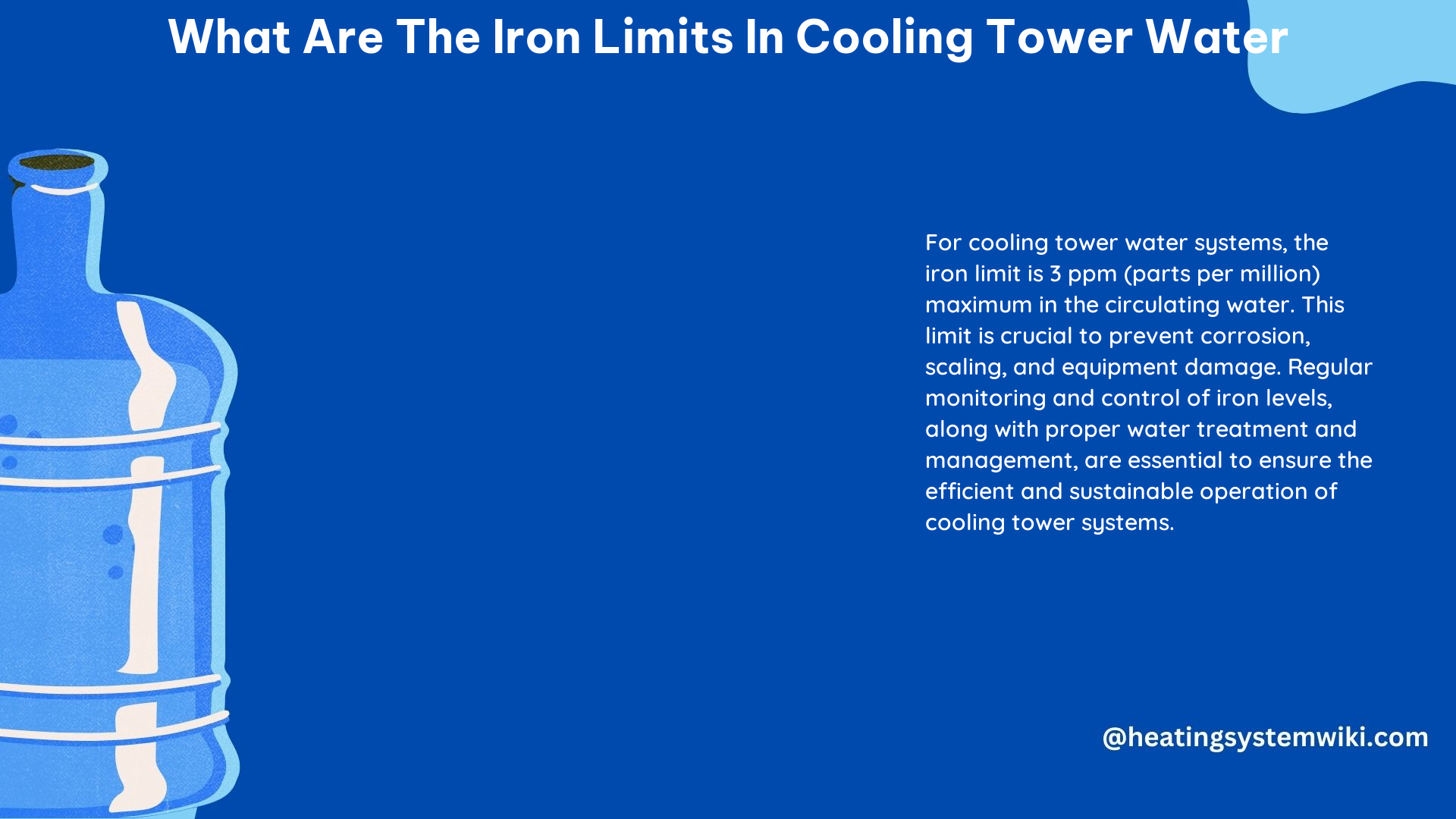The iron limits in cooling tower water are crucial to prevent corrosion and scaling in the system. The common iron analysis measures Total Iron (Total Fe) in the water sample, which includes both iron +2 (ferrous iron) and iron +3 (ferric iron) states. To control corrosion in a carbon steel cooling system, the norm is to measure Total Iron ≤ 0.2 ppm in the cooling water, although more relaxed or tough limits may also be used.
Iron Limits in Closed and Open Cooling Systems
In a closed cooling system with 0.1 ppm Fe in the make-up water, the limit for cooling water is ≤0.3 ppm Fe. For an open recirculating cooling system with cooling tower or evaporative condenser, the number of cycles (NC) should be taken into account. If the number of cycles is 3 and 0.1 ppm Fe is found in the make-up water, the limit for cooling water is ≤0.5 ppm Fe.
It’s important to note that if the cooling system has parts in copper or copper alloys, the copper concentration should also be monitored, with the norm being Copper ≤ 0.05 ppm Cu in the cooling water.
Exceeding Iron Limits and Corrosion Prevention

Exceeding the iron limits in cooling tower water can lead to the formation of insoluble hydroxides, which may deposit on heat-exchanger surfaces and result in equipment corrosion. To prevent this, dispersion provides an approach to the control of the deposition of iron-based compounds such as iron oxide, iron hydroxide, ferric phosphate, and precipitates of polymeric ferric ions, hereinafter referred to as iron(III).
Polymers, such as poly(acrylic acid) (PAA), have been used extensively in industrial water systems to prevent the precipitation and deposition of scale-forming inorganic salts and as dispersants for iron(III). However, the role of PAA may be adversely affected by the formation of insoluble iron phosphate precipitates.
Maleic Anhydride-Ammonium Allylpolyethoxy Sulphate Copolymer as Dispersant
A maleic anhydride (M)/ammonium allylpolyethoxy sulphate (S) copolymer (MSn) has been examined as an environmentally friendly dispersant to control iron(III) scaling in industrial cooling water systems. The synthesized MSn copolymer was characterized by Fourier-transform infrared spectroscopy (FT-IR) and thermogravimetric analysis (TGA). The ability of MSn to disperse iron(III) increased as the value of n increased from 5 to 13; however, the ethylene oxide chain in MS20 was so long that the molecule readily curled and hence its dispersion capability towards iron(III) decreased.
Common Iron Deposits in Cooling Waters
In cooling waters, Fe2O3 (hematite) and FeO (iron oxide or wustite) are the two most common iron deposits. However, magnetite (Fe3O4) is rarely encountered in cooling systems because it needs high temperatures and/or anaerobic conditions. Most magnetite found in cooling systems arrives via airborne or waterborne solids.
Controlling Iron Levels with Dispersants
When the circulating water iron levels are ≤1 mg/L, the system can normally be controlled by incorporating a dispersant in the water treatment formulation. The dispersant helps to prevent the precipitation and deposition of iron-based compounds, maintaining the iron in a suspended state and preventing scale formation on heat exchanger surfaces.
In summary, the iron limits in cooling tower water are typically ≤0.2 ppm for carbon steel systems, ≤0.3 ppm for closed systems, and ≤0.5 ppm for open recirculating systems with 3 cycles of concentration. Exceeding these limits can lead to corrosion and scaling, which can be mitigated through the use of dispersants like maleic anhydride-ammonium allylpolyethoxy sulphate copolymers. Monitoring and controlling iron levels is crucial for the efficient and reliable operation of cooling tower systems.
References:
- Stadalninkiene, K. (2017). Are you controlling the corrosion in your Cooling System? LinkedIn.
- Zhou, Y., Fu, C., Huang, J., Xie, H., Liu, G., Wu, W., & Sun, W. (2010). Control of Iron(III) Scaling in Industrial Cooling Water Systems by the Use of Maleic Anhydride–Ammonium Allylpolyethoxy Sulphate Dispersant. Journal of Chemical & Engineering Data, 55(5), 1187-1193.
- Lubrizol. (2015). Water Chemistry Impacts on Cooling Water System Iron Oxide Dispersants. Retrieved from https://www.lubrizol.com/-/media/Lubrizol/Water-Treatment/Documents/Carbosperse-Library/Water-Chemistry-Impacts-on-Cooling-Water-System-Iron-Oxide-Dispersants.pdf
- Watertechonline. (2018). Cooling tower water systems, part 2. Retrieved from https://www.watertechonline.com/wastewater/article/15550523/cooling-tower-water-systems-part-2
